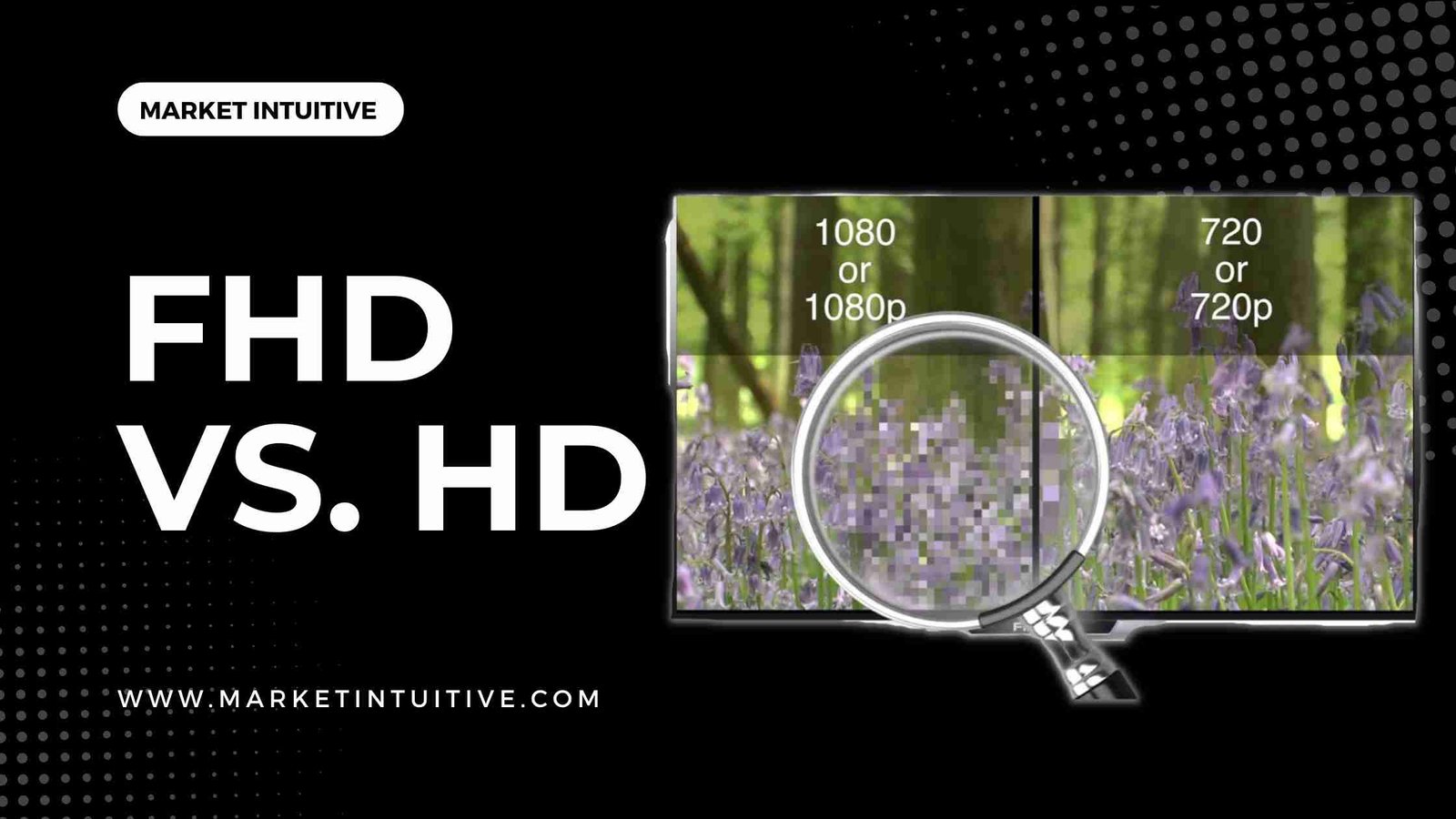FHD vs HD: Which One Is Best For You?

Are you trying to decide between an FHD vs HD display? After all, if you want to watch a movie or show, you don’t want to be left squinting at a grainy, low-resolution image.
With the advancement of technology, the visuals on our screens have become clearer and more detailed than ever. But with so many options, it can be hard to decide which display to choose. FHD and HD displays have advantages and disadvantages, so it’s important to understand their differences to make an informed decision.
Fortunately, there are two main types of high-definition displays to choose from Full HD (FHD) and HD. Both offer great image quality, but which one is best for you? Let’s take a closer look at FHD vs HD displays and find out. This article will discuss the key differences between FHD and HD displays so that you can make the right choice for you.
What Is FHD Screen Resolution?
FHD stands for Full High Definition and represents 1920 x 1080 pixel resolution. 1920 represents the panel’s width in this illustration, whereas 1080 indicates the digital panel’s height. The total number of pixels available on an FHD display in a single frame is 1920 times 1080, which is about 2073600 pixels.
FHD is the most common term you will come across while browsing standard TVs and monitors. FHD displays have been the industry standard for smartphones, monitors, TVs, and laptops for over a decade.
The FHD resolution is not indicative of the physical size of the display. Even with smartphones that fit right in your pocket, you may discover display panels with FHD resolution. It is the quality of the panel that powers the display.
A higher FHD quality means seeing more pixels on the screen, no matter its size. The 16:9 aspect ratio of FHD quality images is similar to most common display screens in the market.
What is HD Screen Resolution?
Many users still prefer an HD display for their TVs or monitors since HD used to be the standard for digital panels. FHD displays are trendy now, so you can easily find an HD display at an extremely affordable price that would be ideal for things like security cameras, secondary monitors, or compact personal TVs.
The HD nomenclature denotes 1280 x 720 pixels panel resolution and consists of 921600 pixels. HD displays offer 2.25 times lesser pixel density compared to standard 1080p panels. Therefore, the image quality on an HD display will be significantly lower for the identical size than that of a 1080p display panel.
Despite this, HD display panels are still valuable because they provide fast image output, which is critical in many situations.
In addition, HD displays are ideal for small, portable laptops because they are productive. As they are focused on productivity-focused tasks, HD displays provide adequate quality.
What is Display Resolution?
So far, I have discussed various types of display panels and how they differ in quality. The primary difference in these display panels is the digital resolution available at the display. But, if you are still determining display resolution, you should stick around and find its importance.
Every digital image on an electronic device has a particular capacity, also known as “image resolution.” Pixels make up digital images on TV, smartphone, laptop, or computer, and there are millions of them.
The pixel density varies along with the resolution capacity of the display. For example, a 480p display can offer up to 409920 pixels, whereas a 4K display offers 8294400 pixels; due to the difference in the number of pixels available per unit size of the display, the overall quality and color accuracy of the digital image changes based on its resolution.
Therefore, you can understand why the resolution is a significant specification of a digital display and why you should always consider it before you buy a new TV or monitor. The resolution should also be checked for compact devices like laptops and smartphones, as it is a permanent system specification and cannot be upgraded later.
Importance of Display Resolution
If you have understood display resolution, you can imagine why it is important to acknowledge it before making a purchase.
You should always prefer the best resolution display available under your budget to get better image quality, sharpness, and color accuracy. However, the requirements regarding the display resolution might change based on the product you are buying.
If you buy a new generation smart TV, you will come across hundreds of options with sizes varying from 32 to 85 inches. As the physical display size increases, the necessity for higher resolution also increases.
If your display has more space, it should also offer a similarly higher pixel count to compensate for the size. If you end up with a large screen with a comparatively smaller resolution, you will find the image quality blurry and stretched out, which is very unpleasant.
Another important factor is the content you will render on your display. If you are buying a gaming monitor, you have to make sure that it supports the same resolution output as your graphics card.
If you play games at 720p or 768p resolution, then it is not a good idea to buy a 1080p or 1440p monitor. Playing lower-resolution content on a higher-resolution display would result in blurry image quality.
Thus, the content you are playing on the display must match the display resolution.
FHD vs HD
By now, you must have understood the major differences, and you will probably choose a display between FHD and HD resolution as these are the most popular options on the market.
By checking out our take on FHD vs HD display panels, you can easily understand the differences between these options and what you can expect from your purchase.
| Parameters | FHD Display | HD Display |
| Resolution of the panel | 1920 x 1080 pixels | 1280 x 720 pixels |
| Pixel capacity | 2073600 | 921600 |
| Width of the digital panel | 1920 | 1280 |
| Height of the digital panel | 1080 | 720 |
| Suitable display size | 28 inches or lower | 19 inches or lower |
| Ideal viewing distance | 1.5 feet to 3.9 feet | 1 foot to 2.7 feet |
| Suitable applications | Gaming, entertainment, content creation. | Productivity tasks, office usage, secondary monitors. |
FHD vs HD Ready
There is yet another standard for digital displays called “HD Ready.” You will often find a series of mid-range smart TVs with this nomenclature suitable for most casual users.
HD Ready represents a resolution of 1366 x 768 pixels, resulting in a total pixel capacity of 1049088. As you might have guessed, HD Ready display panels are slightly better than HD panels, with a pixel capacity of 921600.
The increased pixel capacity certainly offers better image sharpness and clarity for the same physical size of the display. Compared to FHD displays, the HD Ready displays still fall behind in terms of overall quality.
However, it is a perfect middle ground between FHD vs HD display panels. See the quick comparison below if you wish to know more about HD Ready display and how it competes with FHD.
| Parameters | FHD Display | HD Ready Display |
| Resolution of the panel | 1920 x 1080 pixels | 1366 x 768 pixels |
| Pixel capacity | 2073600 | 1049088 |
| Width of the digital panel | 1920 | 1366 |
| Height of the digital panel | 1080 | 768 |
| Suitable display size | 28 inches or lower | 21 inches or lower |
| Ideal viewing distance | 1.5 feet to 3.9 feet | 1.1 feet to 2.9 feet |
| Suitable applications | Gaming, entertainment, content creation. | HD TV shows, mid-range gaming build, office computers. |
.
FHD vs HD: Which Is Better?
Well, it should be obvious by now that the number of pixels on FHD is the best choice, regardless if you’re going to use this at your home, office, or elsewhere.
Here are 3 questions to help you determine which is better, FHD vs HD:
1. Are you planning to use your television for gaming at home?
Ask any gamer about recommended screens, and you’ll get 1080 pixels as the lowest image resolution acceptable. Of course, you’d have to consider whether the TV can support the games you want. Definitely, between FHD vs HD, FHD is well-suited for gamers.
2. Are you looking for a TV with the best real estate?
If you’re trying to find a TV that would serve as your monitor, go for FHD as it can provide a bigger screen space and the content is displayed without quality being compromised. Also check UHD, 4k, 8k, and other similar products for more options.
3. Are you worried about future-proofing?
HD and FHD are outdated resolutions. If you’re concerned with future tech and services, you should find a way to utilize an obsolete TV and order Ultra-HDTVs like 4k or 8k instead, and FHD is a better option in this situation.
FAQs on FHD vs HD
1. Which is the best display resolution?
When it comes to displays, there are many important factors to consider: resolution, viewing angle, color accuracy, and brightness, to name a few.
The answer depends on your needs and preferences. FHD (1920×1080) offers more pixels than HD (1366×768), providing a sharper image. If you plan to watch TV or movies or play video games on your laptop, FHD is the better option, between FHD and HD.
However, if you mostly use your laptop for productivity tasks such as word processing and spreadsheet work, then HD may be adequate. Remember that the higher the resolution, the more power your laptop will need to display the image correctly. So if you have an older laptop, stick with HD.
2. Is FHD good enough?
In the market for a new television? You may wonder if Full High Definition (FHD) is good enough. The answer is yes! FHD has a resolution of 1920×1080, which is more than enough to provide a high-quality picture.
In addition, FHD televisions are becoming increasingly affordable, so you can get a great picture without breaking the bank.
3. What is the difference between FHD vs HD display?
The primary distinction between FHD vs HD resolution is the image size. HD can refer to resolutions of 720p or 1080p. FHD resolution, on the other hand, is defined as 1080p tall (height) and 1920 pixels wide.
4. Should I buy 4K or FHD?
The higher resolution, the better 4K, and FHD are some of the terms used to describe the screen resolution of a television.
HD-ready displays have a resolution of 1,366 x 768 pixels, FHD displays have a resolution of 1,920 x 1,080 pixels, and 4K displays have a resolution of 3,840 x 2,160 pixels. The higher resolution provides a detailed image.
If you have the budget, I recommend purchasing a 4K television.
Conclusion
After going through our guide, I hope you fully understand the difference between FHD vs HD display and its importance. I have also offered significant differences between display types like HD, FHD, and HD Ready so that you can choose the best suited for your application.
You can find this information in our guide if you need clarification on how the display resolution affects the performance and image quality.
Related Article:
Crystal UHD vs LED: Which One Is Best For You?
Nanocell vs UHD: Which One Is A Better TV?






